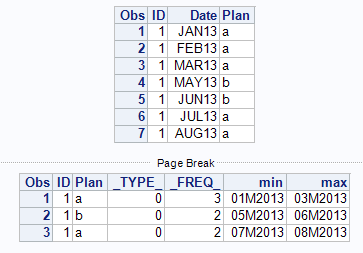- Home
- /
- Programming
- /
- SAS Procedures
- /
- Re: OUTPUT
- RSS Feed
- Mark Topic as New
- Mark Topic as Read
- Float this Topic for Current User
- Bookmark
- Subscribe
- Mute
- Printer Friendly Page
- Mark as New
- Bookmark
- Subscribe
- Mute
- RSS Feed
- Permalink
- Report Inappropriate Content
Hello All,
I was trying to create an output for the dataset
ID Date Plan
1 jan2013 a
1 feb2013 a
1 mar2013 a
1 may2013 b
1 jun2013 b
1 jul2013 a
1 aug2013 a
the output i'm looking to get is ID Plan Date_range
1 a 1-3
2 b 5-6
3 a 7-8
Thanks. Looking forward to some responses.
Accepted Solutions
- Mark as New
- Bookmark
- Subscribe
- Mute
- RSS Feed
- Permalink
- Report Inappropriate Content
You can format the min and max into date range yourself right?
input ID Date:monyy. Plan :$1.;
format date monyy.;
cards;
1 jan2013 a
1 feb2013 a
1 mar2013 a
1 may2013 b
1 jun2013 b
1 jul2013 a
1 aug2013 a
;;;;
run;
proc print;
run;
proc summary data=date nway;
by id plan notsorted;
format date mmyy.;
output out=range min(date)=min max(date)=max;
run;
proc print;
run;

- Mark as New
- Bookmark
- Subscribe
- Mute
- RSS Feed
- Permalink
- Report Inappropriate Content
You can format the min and max into date range yourself right?
input ID Date:monyy. Plan :$1.;
format date monyy.;
cards;
1 jan2013 a
1 feb2013 a
1 mar2013 a
1 may2013 b
1 jun2013 b
1 jul2013 a
1 aug2013 a
;;;;
run;
proc print;
run;
proc summary data=date nway;
by id plan notsorted;
format date mmyy.;
output out=range min(date)=min max(date)=max;
run;
proc print;
run;

- Mark as New
- Bookmark
- Subscribe
- Mute
- RSS Feed
- Permalink
- Report Inappropriate Content
Thank you so much for the help.
Learn the difference between classical and Bayesian statistical approaches and see a few PROC examples to perform Bayesian analysis in this video.
Find more tutorials on the SAS Users YouTube channel.
SAS Training: Just a Click Away
Ready to level-up your skills? Choose your own adventure.



